
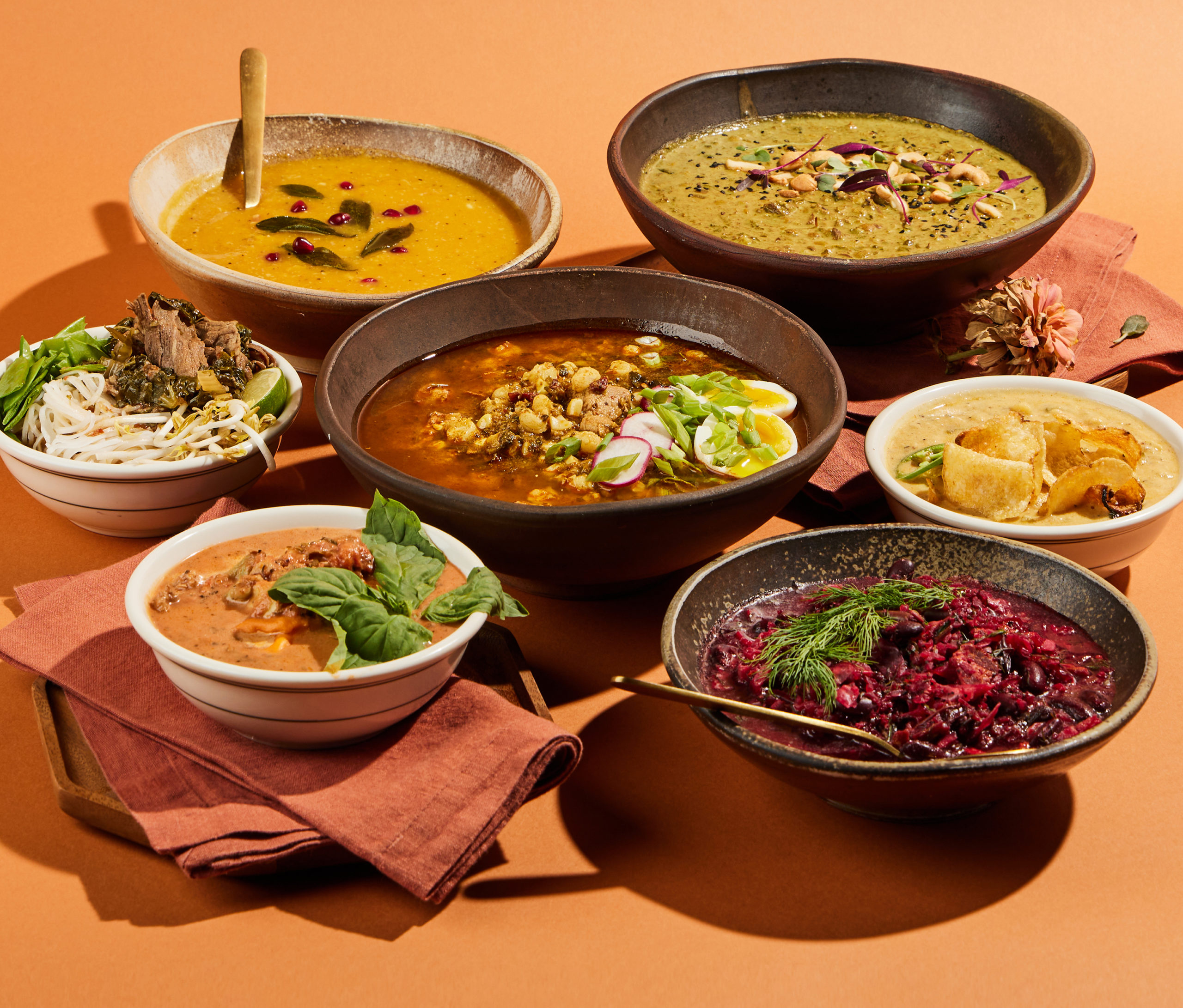
It’s soup season.
Here are 11 BOWLS of comfort around KC, including the revival of an iconic steak soup and life-changing clam chowder.
WORDS MARTIN CIZMAR, NATALIE TORRES GALLAGHER, MARY HENN
PHOTOGRAPHY ZACH BAUMAN, CALEB CONDIT, REBECCA NORDEN
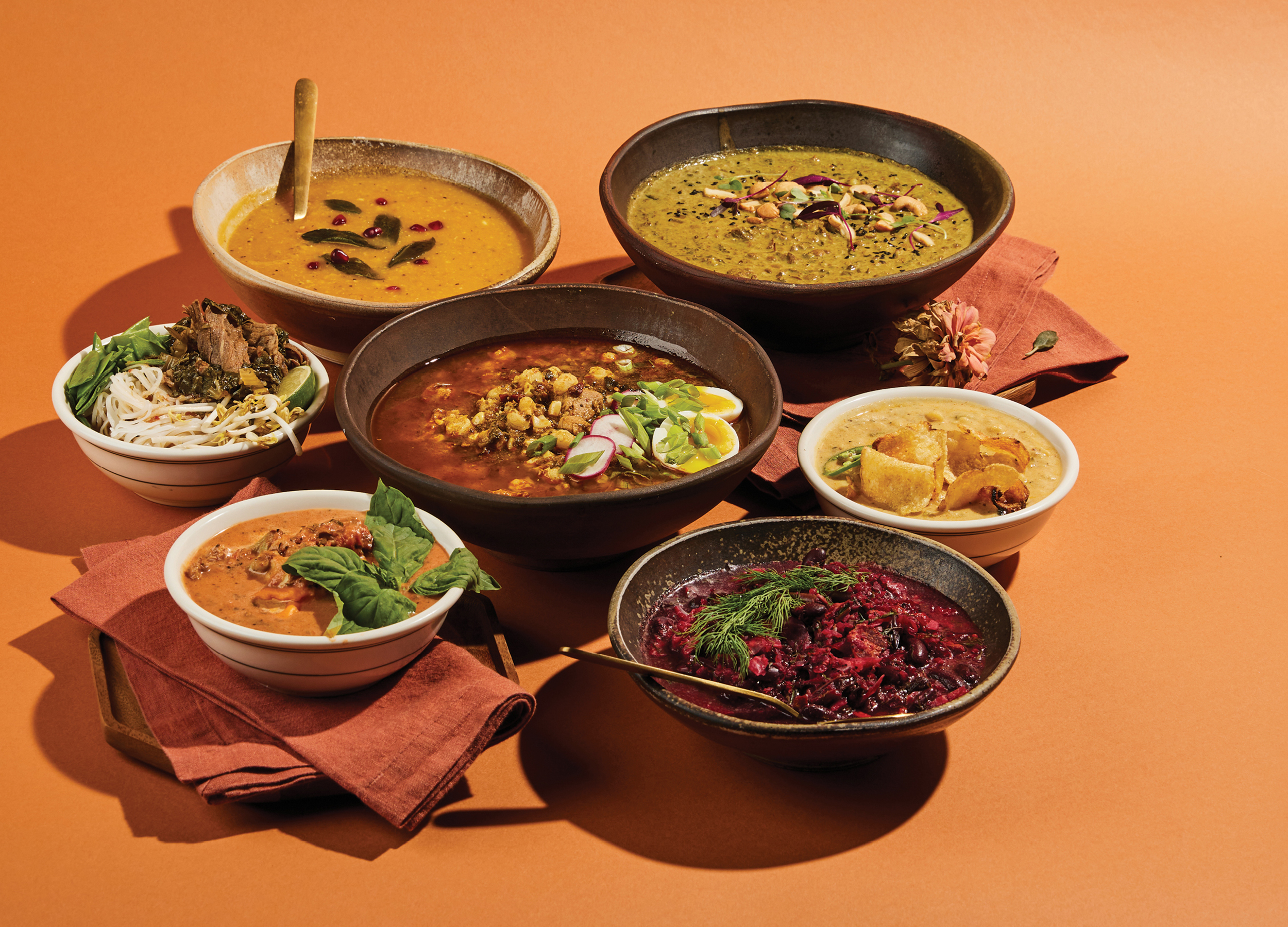
The soups at Housewife in Grandview have developed a cult following.
It’s an iconic bit of television, known even to those who have never seen an episode of Seinfeld: A new soup stand opens up and, despite the owner’s grumpiness—he is known to patrons as the “Soup Nazi”—there is always a line of devotees obediently following the shop’s stringent etiquette.
In Grandview, regulars at daytime cafe Housewife (801 Main St., Suite 104, Grandview) affectionately refer to Anna Sorge with the same nickname. This has a good deal more to do with Sorge’s culinary talent than it does with her person: As she bounces between the small kitchen and the bakery counter at her restaurant, Sorge is ceaselessly cheerful, a smile permanently pressed beneath twinkling eyes. (This is not a woman who would shout “No soup for you!” at a customer who dared ask for a side of bread.)
When Housewife opened earlier this year, it quickly gained a reputation for its flavorful stews: a rich Philly cheesesteak concoction with beef so tender you’re afraid you might hurt it, pork pozole that sells out even on ninety-degree summer days. She grabs inspiration from around the globe—any excuse, she says, to work with bold spices and try new flavors. She’s made twenty-two different soups since opening, rotating two through each day.
“My neighbors are from Pakistan and one Sunday, I smelled something amazing coming from their kitchen,” Sorge says. It turned out to be haleem, an emerald-green stew made with beef, barley, lentils and yogurt and seasoned liberally with cumin and garam masala. For her version, Sorge gives lamb and beef tenderloin a mint-coriander rub and braises them overnight.
“Soup is such a humble dish, and for a lot of restaurants that I’ve worked in, it’s mostly an afterthought, a way to use leftovers,” Sorge says. “But when done right and intentionally, when you do something from scratch on purpose, you end up with so much flavor.” —Natalie Torres Gallagher
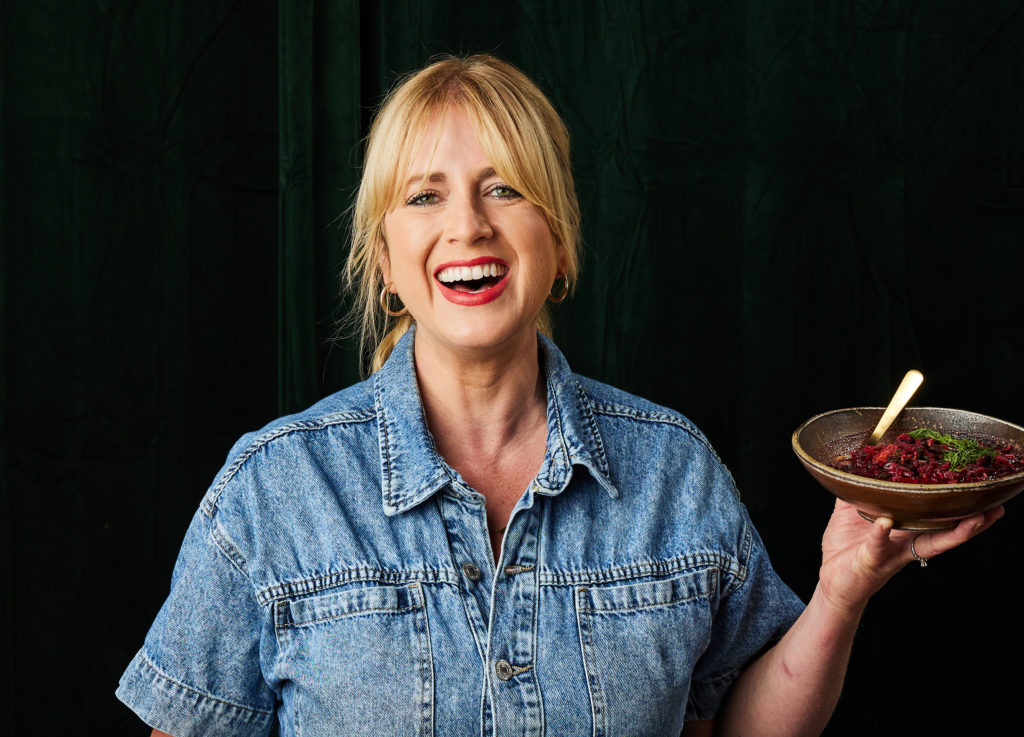
Photography Caleb Condit and Rebecca Norden
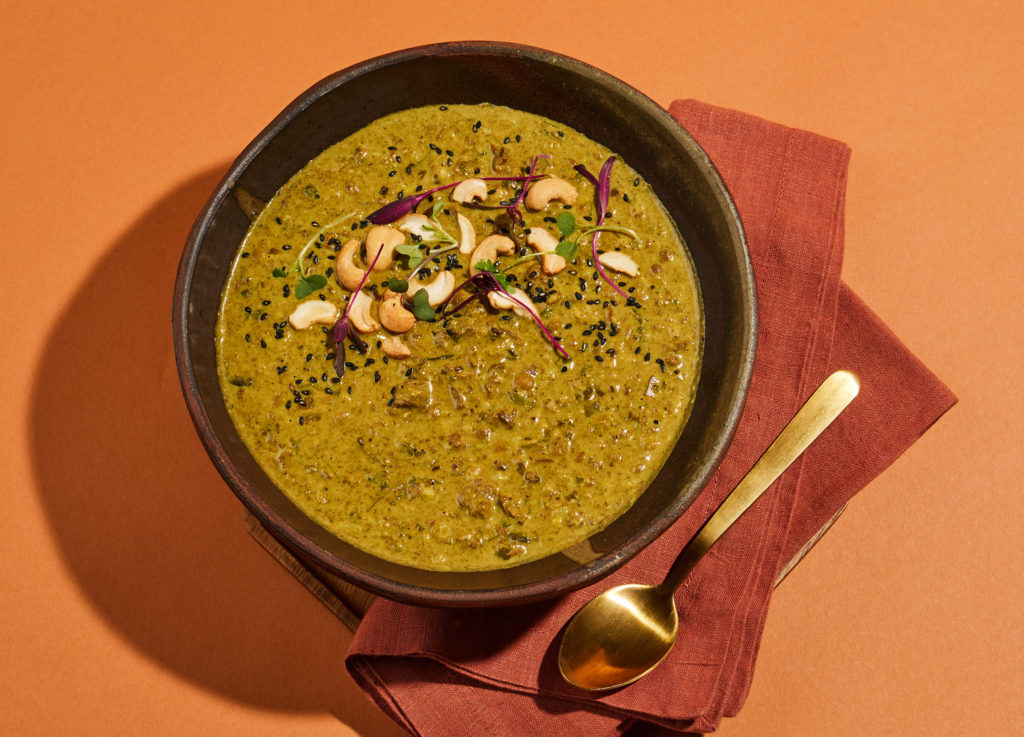
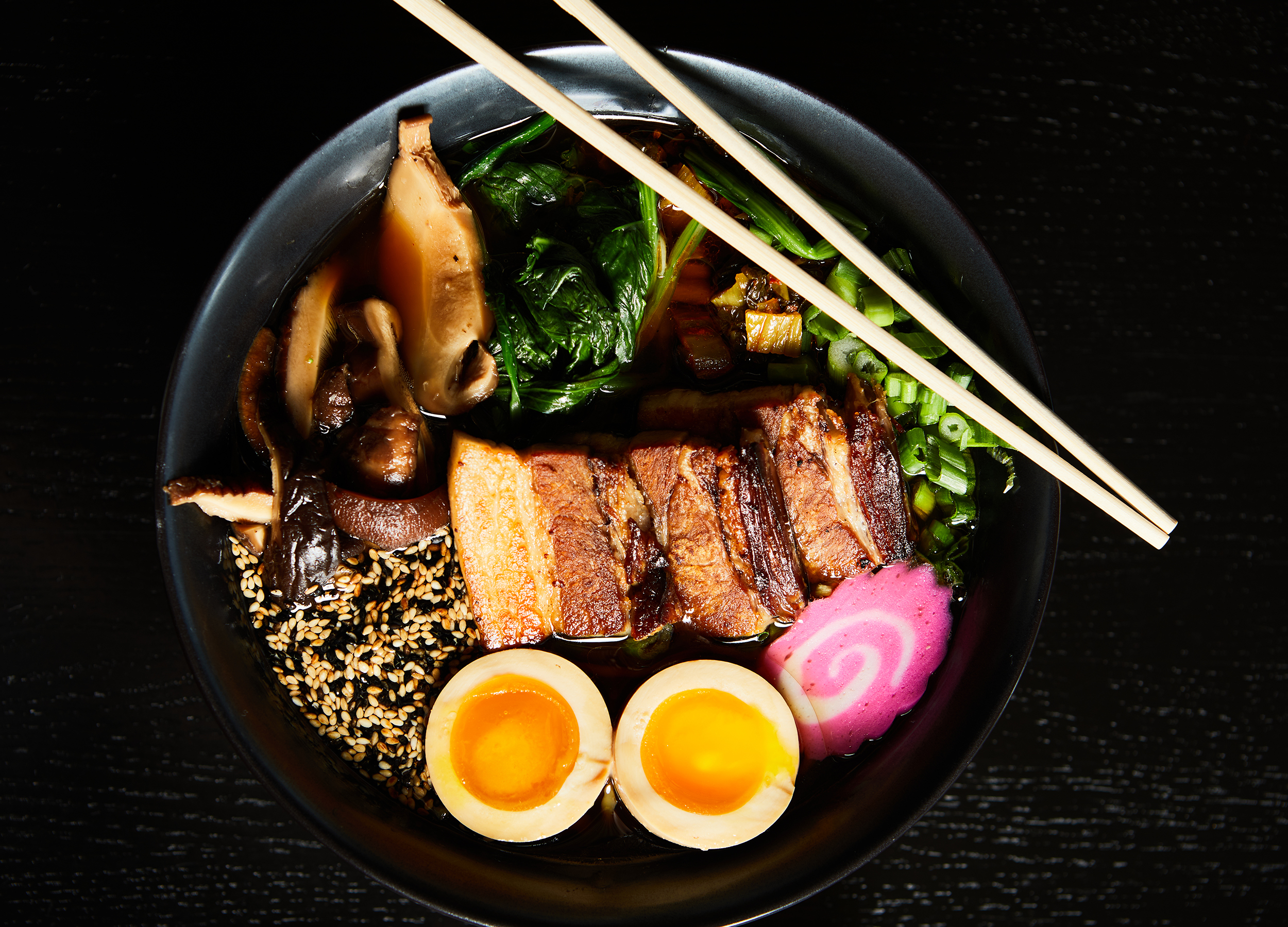
Bōru changed its broth recipe during the pandemic, and the result is a better, bonier broth.
At Bōru (500 W. 75th St., KCMO), they’ve got bones. You might not want to know what bones, says Po Wang, the restaurant’s culinary director, since superbly rich broths are a byproduct of “feet and stuff.”
“That’s what creates the richness and the mouthfeel of the broth—the collagen,” Wang says. “Unlike a lot of places, we actually start with bones. I use whole chickens, plus vegetables, plus all the pork bones, all the aromatics, plus sake, and it goes for eighteen to twenty hours.”
All those bones go in one big pot—it’s large enough to hold two adult men and is kept in the kitchen at Summit Grill next door because Borū is too small—and boils for nearly a day. It’s a variation on their pre-Covid recipe, where the meat broths were separate. Now, they have a “master” meat broth with both pork and chicken and a vegetarian broth.
“We combined everything to make it easier, and we found it tasted way better,” he says. “It’s richer.”
Indeed, a bowl of spicy miso, which gets even more umami from ground pork stewed in bean curd, kombu, miso and shiitake mushrooms, is the richest and best bowl of ramen I’ve had in KC. The kombu is the secret ingredient, even beyond the bones.
“It’s kelp, so that’s super umami,” Wang says. “The depth of it is awesome.” —Martin Cizmar
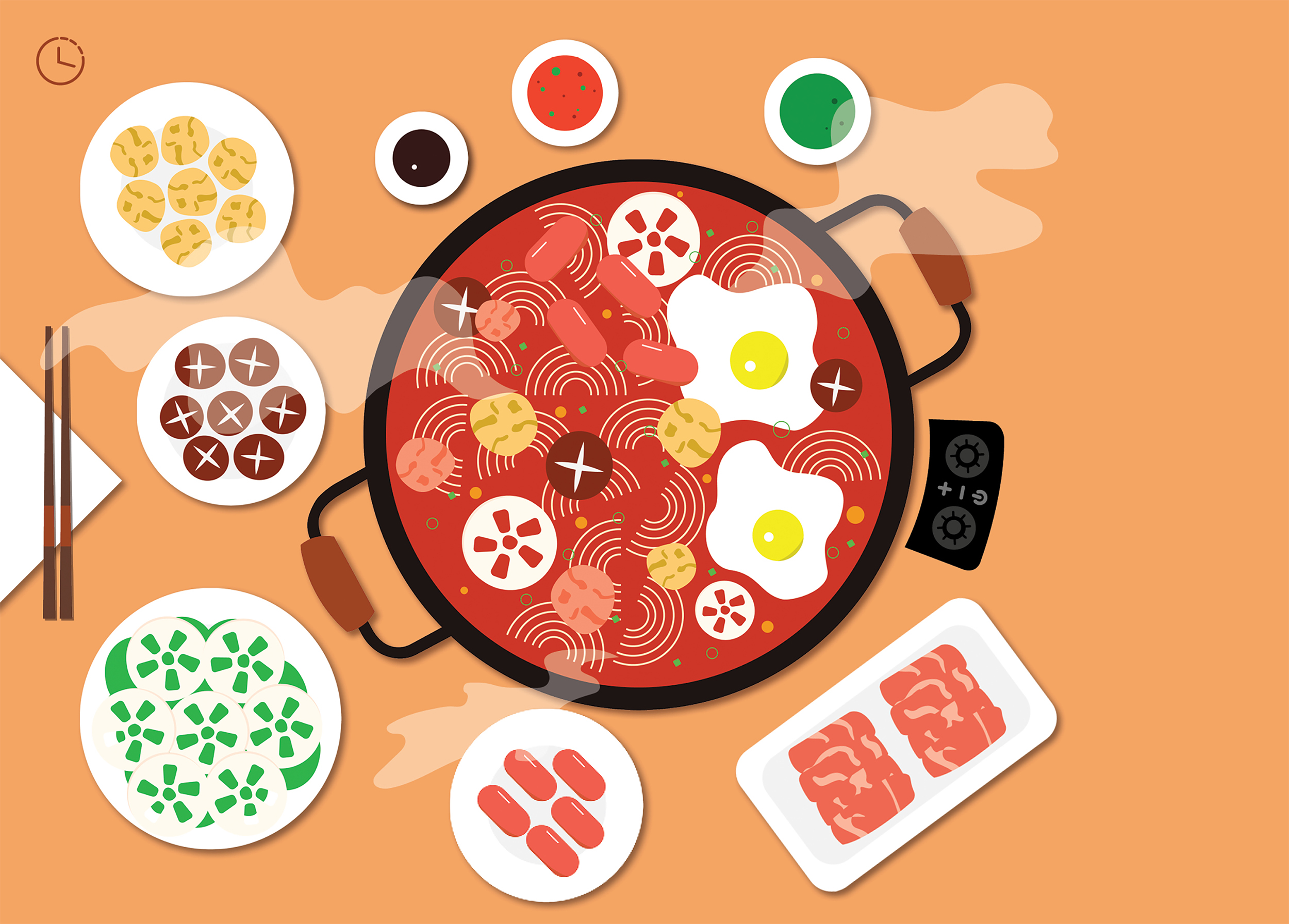
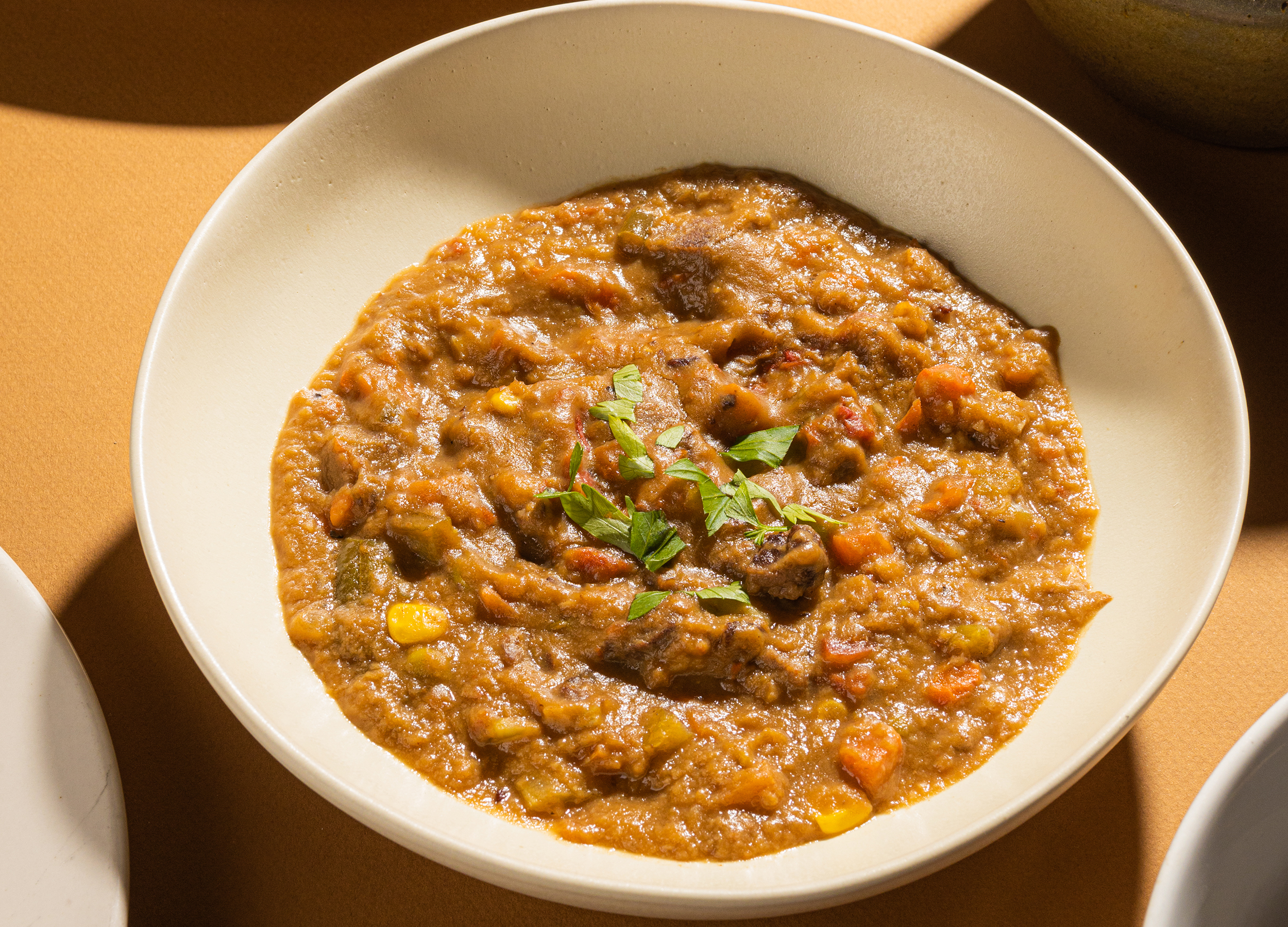
Photography ZACH BAUMAN
Plaza III’s iconic steak soup returns via mail order.
When Plaza III closed after fifty years, Eric Gonsher thought the local steakhouse staple was “too good to let go.” Gonsher, whose only affiliation with the old location was being a frequent lunch guest, got together with a team to purchase all of Plaza III’s intellectual property, including the brand and a massive trove of recipes. They hired a former chef, Linzie Davis, to prepare those dishes for a relaunched brand, which sells the steakhouse’s menu by mail order.
“We had a hundred pages of recipes, but being able to execute them the way they were executed in the restaurant was extremely important to us,” Gonsher says.
Among those recipes, none was more important than the steak soup.
“Out of all of the Plaza III menu items, the steak soup was by far the most popular and the most sought-after,” Gonsher says. “The steak soup has always been the hallmark of the Plaza III.”
Steak soup is so quintessentially KC that it’s hard to imagine it emerging anywhere else. When publications like Midwest Living have published recipes for it, they’ve called it “Kansas City Steak Soup.” But none are the exact Plaza III recipe, Gonsher says.
“If you Google steak soup, there are a lot of copycat recipes online, so we’re not disclosing the exact recipe, but it’s not a huge secret either,” he says. “It’s really hearty vegetables—celery, carrots, all that stuff—and then a pretty hearty broth and big chunks of steak. The steak is really what makes it. We only use high-quality steaks for all the menu items, including the steak soup.”
The reborn Plaza III has shipped food to twenty-five different states via bestofplazaiii.com, which was a surprise to Gonsher: “We thought it was going to be mostly Kansas City, but we were wrong.” —Martin Cizmar

The longer the rich cake sits at the bottom of Spicy One’s Lontong Sayur, the better it tastes.
The turkey legs at Spicy One (6551 W., 119th St., Overland Park) are popular. When I pop in at the tail end of a lunch rush, the woman taking my order at the counter assumes that’s what I’m after. And while I appreciate the broadened availability of this coveted hunk of meat outside of RenFest, I am after something even rarer: lontong sayur, a dish popular in Indonesia but scarce outside of its home country.
Unless you’re familiar with this soup, it may be difficult to anticipate what the amalgamation of ingredients will result in. In the sayur, a silky coconut broth flavored with a slightly sour chili paste called sambal, you’ll find find hearty long beans, thick cuts of fried tofu, kerupuk (thin, pastel-colored crackers with a puffcorn texture) and lontong—a dense, steamed rice cake that absorbs more flavor the longer it sits in your bowl.
In Indonesia, lontong sayur is enjoyed for breakfast, lunch or dinner. A bowl of it from Spicy One could easily carry you through a day of meals, too. —Natalie Torres Gallagher

Photography ZACH BAUMAN
A few Midwestern touches have made Café Provence’s French onion soup a staple.
There’s a reason the concept of “soup weather” exists—most people agree a steaming bowl is just a little better on a damp and chilly day. Don’t tell the people ordering the French onion soup at Café Provence (3936 W., 69th Terrace, Prairie Village) on the hottest day of the year. While seated on the patio.
“I always joke and say even when it’s a hundred degrees outside, we still sell onion soup,” says Philip Quillec, executive chef at the homey French bistro.
Onion soup has been on the menu since Café Provence opened twenty years ago. In France, onion soup was traditionally a simple blue-collar workers’ meal. In Prairie Village, they use beef broth and caramelized yellow onions cooked with bacon. “It’s something that is a little bit of an Americanized touch to a French onion soup—we put bacon in everything here,” Quillec says.
That soup is topped with Provence’s French baguette and a Midwest-thick layer of Emmentaler cheese with just a bit of Gruyère.
“We put a lot of cheese on there, and you kind of need it to get that caramelization on top,” Quillec says. “If you don’t put enough on there, when you go to broil it to get that crispy top, it will sink into the soup. Also, people love cheese.” —Martin Cizmar
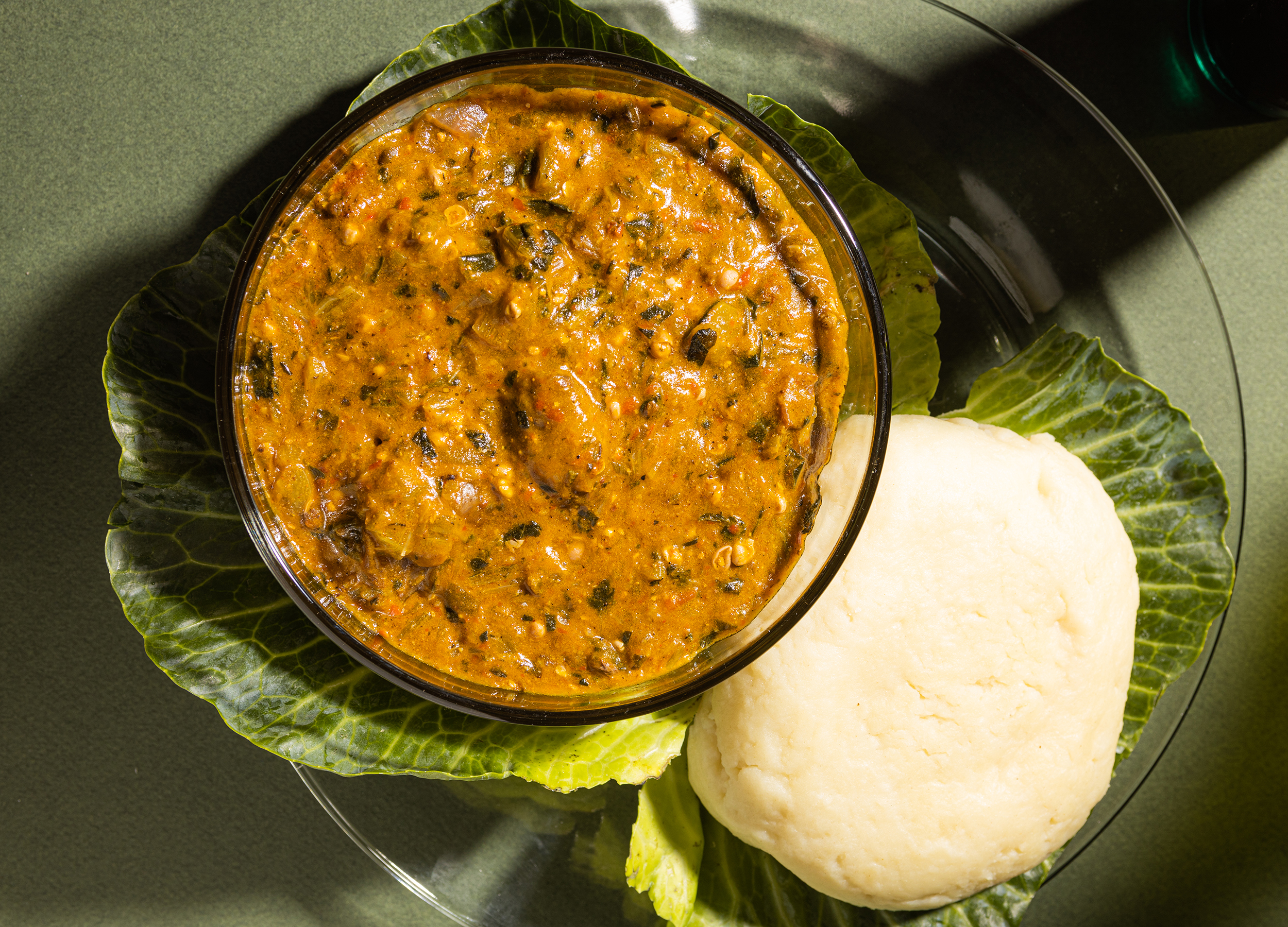
Photography ZACH BAUMAN
Wah Gwan brings traditional West African comfort food to KC with its Nigerian soups.
Tanyech Yarbrough opened Wah Gwan (6228 Troost Ave., KCMO) just before the pandemic hit. The Brooklyn-raised Yarbrough was born in Jamaica and has always loved cooking and entertaining. But when she opened her restaurant on Troost, she wanted to expand the menu beyond traditional Jamaican food staples and offer Nigerian dishes, too. Yarbrough’s partner is Nigerian and helped inspire the restaurant’s unique fusion of flavors and influences.
Part of that Nigerian influence includes egusi, which Yarbrough says is an “introduction to our soups.” Egusi, which is similar to gumbo, is made with melon seeds, African spices, and chicken or goat. “Now, egusi has become very popular,” Yarbrough says. “Before, people who weren’t familiar with Nigerian dishes would stick to our Jamaican dishes, but once they tried Nigerian food, they liked it.”
After egusi, Wah Gwan added bitter leaf and okra soup to its Nigerian soup list. The okra soup is made with spinach, African spices and goat. The cooked okra and spinach are tender and subtle while the spice blend and goat carry the flavor of the dish. All three soups are typically served with fufu, a dough-like ball of cassava.
Wah Gwan’s soups gained local popularity by happy accident after fufu became a trend on TikTok last year.
“I had people calling and ordering just fufu,” she says. “I would ask which soup they wanted with it because fufu by itself is very bland. That’s when I first started recommending our soups.” —Mary Henn
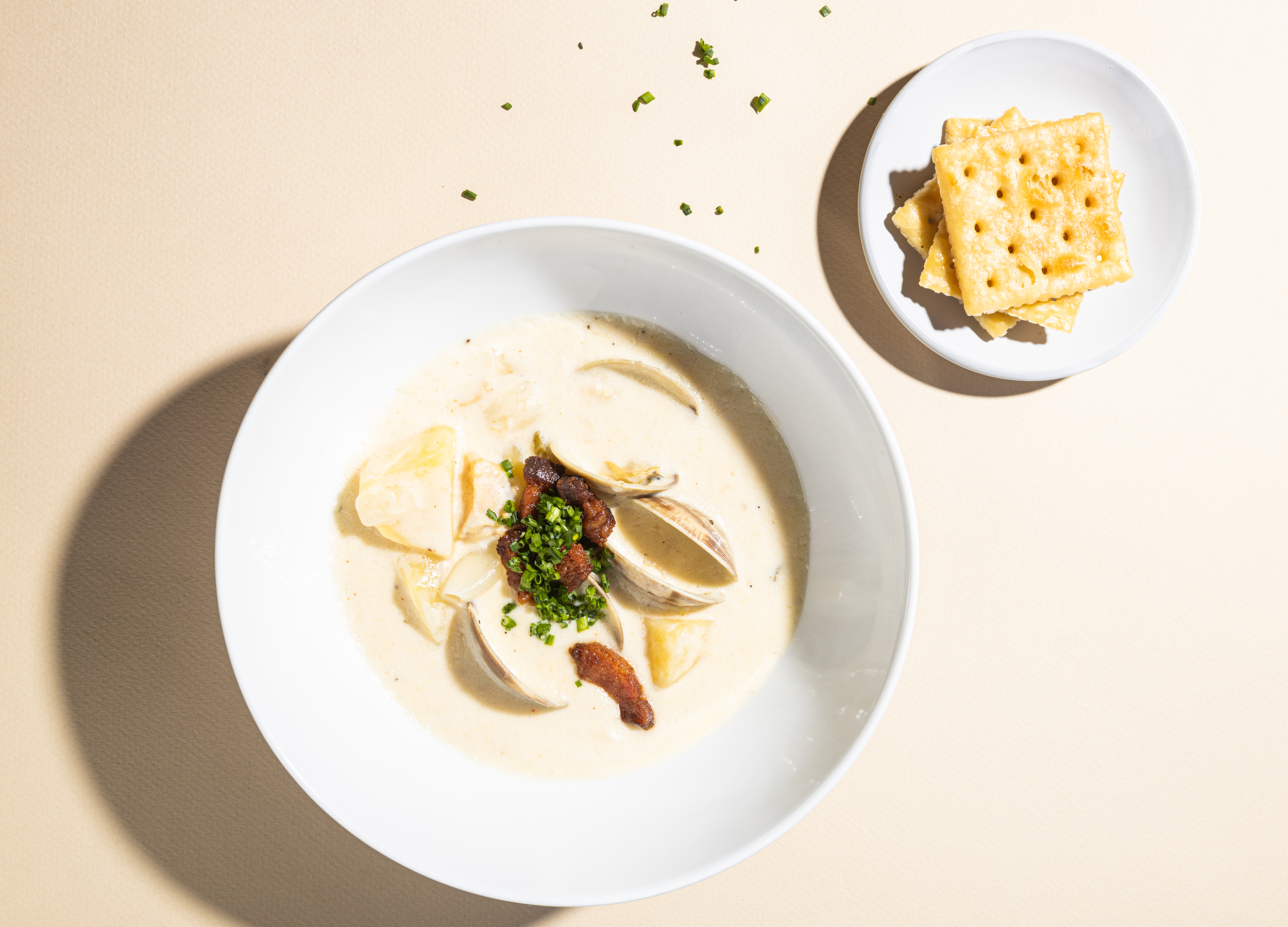
Photography ZACH BAUMAN
The new Earl’s Premier makes a showstopping clam chowder.
Summer was already sweltering hot when Earl’s Premier (651 E. 59th St., KCMO) opened in Brookside in early May, but that didn’t stop guests from ordering bowls of the restaurant’s New England-style clam chowder to tables inside and outside. On my first visit, as I watched condensation dribble down the sides of the frozen gin and tonic machine behind the bar and I worried about the sweaty imprint my body would invariably leave on the wooden bench lining the slender dining room, I could think of nothing more punishing than a serving of steamy cream and
clam juice.
The guy at the small marble table next to me had no such qualms. After a single mouthful of his lunch, he released a rhapsodic exclamation that caused the swiveling of heads positioned farther away than my own. “Chef! Chef!” he called, and chef and co-owner Todd Schulte glanced through the kitchen window from his position on the line. “This is incredible, chef. This is insane!” Schulte smiled and spared a thumbs-up. There was further gushing approval as this delighted patron hailed every server for a conversation about the merits of Earl’s clam chowder until, finally, the man turned to me, his spoon scraping the bowl. “Have you had the clam chowder?” he asked without waiting for an answer. “You’re crazy not to. It’ll change your life. You have to try it.”
I assured this stranger I would absolutely order a bowl, omitting the part where I have never cared much for clam chowder—I’ve always found it both too heavy and strangely watery, usually lacking any evidence of actual clams—and he vacated his seat before I had to follow through.
But later, on a steamy July afternoon when I needed a mood booster, I recalled the joy Earl’s clam chowder had conjured. I perched on a barstool, and when my order arrived—a hefty, butter-hued bowl studded with meaty clams peeking over the still surface and a fistful of fat, crispy lardon pieces—I understood what the fuss had been about. —Natalie Torres Gallagher

Cancun Fiesta Fresh brings trendy birria ramen to KC.
Birria has been a staple in Jalisco for thousands of years, but it took dunkable tacos from trendy spots in Tijuana and Los Angeles to make the spiced stew Instagram-famous.
The best and most unique part of birria tacos is the consommé—the cup of rich and fatty broth served on the side for dipping between bites.
In 2015, Antonio de Livier, a celebrity chef in Mexico City, decided to cut out the middle man by introducing birria ramen. The trend soon spread, including to KC’s Cancun Fiesta Fresh (4019 Pennsylvania Ave., KCMO). At this casual spot on the edge of Westport, the consommé becomes the broth, bathing noodles and chunks of tender beef. Add a little cilantro and a squeeze of lime and you have a simple, spicy and very rich bowl of birria, with no need to dip and dribble. —Martin Cizmar

Photography ZACH BAUMAN
Some butcher shops specialize in sausages as a way of using their trimmings. Broadway Butcher makes soup.
There’s a subset of regulars at Broadway Butcher Shop (3828 Broadway Blvd., KCMO) who come to the Midtown shop not for cuts of grass-fed beef or fresh scallops, not even for paper-thin slices of Italian finocchiona to accompany the Lambrusco they purchased at the wine shop next door. This population beelines instead for the slender freezer holding frosty quarts of soup because they know that’s where all the premium steak trimmings end up.
“Our soups are entirely a byproduct of being a butcher shop,” says owner Nate Feldmiller. “It’s a good avenue to use up end pieces of meat, tails of fish, sausage bits that can’t go into the casing. We find uses for the scraps from our premium products, and that in turn helps us keep the price down on those larger cuts—and it gives us some really unique ingredients to work with.”
Case in point: Broadway Butcher’s Hawaiian ribeye soup with chunks of Midwestern beef, pineapple, mango and green peppers in a snappy sweet-and-sour beef broth. Popular offerings include a bracing pozole with slow-roasted pork, spicy cioppino, smoked haddock and potato soup, and even a smattering of vegetarian and vegan options (Broadway stocks local farm vegetables in its grocery section). And you can usually count on a supply of chili.
All soups are sold frozen by the quart ($12–$20), and instructions for reheating are printed on the label. —Natalie Torres Gallagher
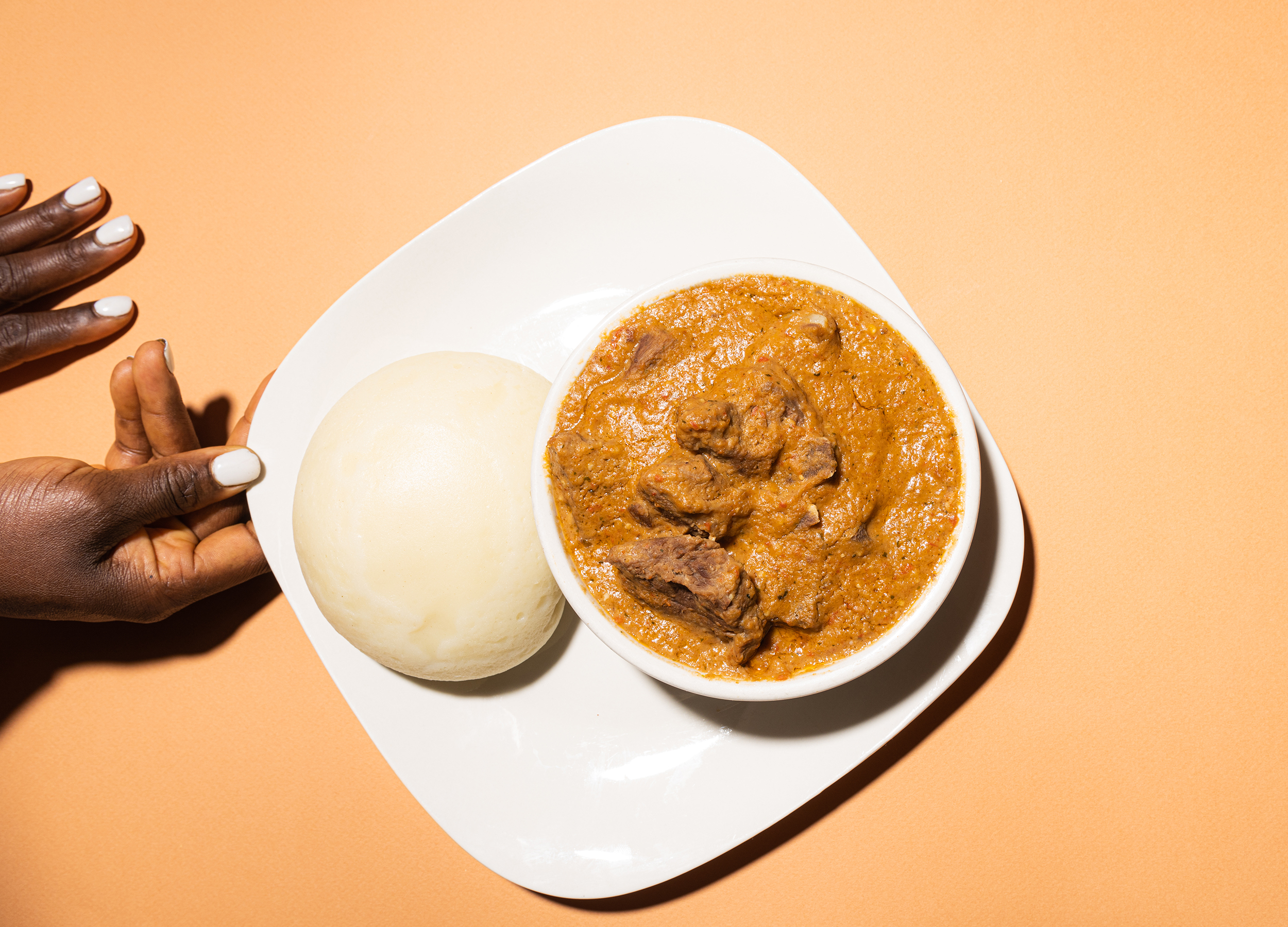
Photography ZACH BAUMAN
Fannie’s famous peanut butter soup is the ultimate cold-weather dish.
It was Fannie Gibson of Fannie’s West African Cuisine in Hyde Park who convinced Wah Gwan’s Tanyech Yarbrough to open her own restaurant in Kansas City. After years of missing her native cuisine, Gibson—who grew up in Liberia during the ’80s—decided to open her own restaurant.
In addition to offering egusi, cassava leaf and okra soup like Wah Gwan, Fannie’s (4105 Troost Ave., KCMO) also serves other traditional African soups like peanut butter soup. Often known as groundnut soup, peanut butter soup is rich and nutty, made with fresh tomato, onions, bell peppers, habanero and African spices. Fannie’s peanut butter soup can be ordered with goat, beef, chicken, shrimp or fish.
The peanut butter soup is typically served with rice or, you guessed it, fufu. There are three different kinds of fufu: cassava, yam and plantain fufu. While the fufu at Wah Gwan is made with cassava, Fannie’s fufu is often made with plantain. Both are wonderfully sticky and full and are similar to mashed potatoes. It’s meant to be dipped in soup and eaten by hand. —Mary Henn


Last year, we did an exhaustive search for KC’s best pho, trying nine different versions of Vietnam’s national dish and being reminded that there is no consensus on what the perfect pho should taste like since Northern Vietnamese pho is nothing like Southern Vietnamese pho, which is what most restaurants in the area serve. The answer to what makes a good pho varies as much as the answer to what makes a good cheeseburger.
If you want to revisit our pho journey (the landscape has not changed much) you can click here to get to that story. Spoiler alert: Pho Lan (315 Cherry St., KCMO) and the Columbus Park Vietnam Cafe (522 Campbell St., KCMO) are both very good.